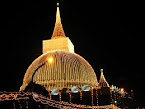Think about a person with many likings. That person might enjoy life in many ways by fulfilling those likings. Once he achieved one of his desires he would expect more to satisfy himself further. Assume due to some unfortunate reason he lost the rhythm of his life. Instead of fulfilling his likings he has to struggle to survive. Compare the suffering he would undergo with someone in contrast who had less likings and desires in life. Obviously, the person with more desires would suffer than the other.
In our life, we can never expect everlasting progress and success. Everything is subject to change. One has to suffer at birth as well as at the death. In between there are many ups and downs in life. More you desire, more you suffer and less you desire, less you suffer.
The Buddhist, who has entered the path of reaching Nibbana would understand this reality and work towards getting rid of all the sufferings. He would understand that this existence is due to past Ignorance (Avijja), Craving (Thanha), Attachment (Upadhana), Kamma, and physical Food (Ahara) of present life. He would understand that everything is subject to Transient (Anithya), Suffering (Dukkha) and devoid of any immortal Soul (Anathma). He would understand that in none of the Realms of existence there is permanent joy or happiness. Therefore he would start Vipassana Bhavana, the meditation to understand things as they truly are.
The “Noble Eight Fold Path” (Arya Ashtangika Margaya) is the path to Nibbana. Enormous effort in Samsara together with this path would make it possible for one to fully realise the Four Noble Truths (Chathurarya Sathya): Suffering (Dhukka), Cause of the Suffering (Dhukka Samudaya), Cessation of Suffering (Dhukka Nirodha), Path leading to the cessation of Suffering (Dukka Nirodha Gamini Patipada).
Out of the 89 types of consciousness, Kamavachara, Rupavachara and Arupavachara chiththas are all non-permanent even though the later chiththas are more pure. They arise in the 31 realms of existence and they are together called “Mundane Consciousness” or “Lokiya Chiththas”. The consciousness arise in the path of Nibbana, the supreme of all consciousness, are called “Supramundane Consciousness” (Lokuththara Chiththas) and they are two fold as Path-Consciousness (Marga Chiththas) and their corresponding Fruit-Consciousness (Pala Chiththas);
Supramundane Path-Consciousness (Lokuththara Marga Chiththas) - 4
1. Sothapaththi Marga Chiththa
Sothapaththi Path-Consciousness
2. Sakadhagami Marga Chiththa
Sakadhagami Path-Consciousness
3. Anagami Marga Chiththa
Anagami Path-Consciousness
4. Arhath Marga Chiththa
Arhath Path-Consciousness
Supramundane Fruit-Consciousness (Lokuththara Pala Chiththas) - 4
5. Sothapaththi Pala Chiththa
Sothapaththi Fruit-Consciousness
6. Sakadhagami Pala Chiththa
Sakadhagami Fruit-Consciousness
7. Anagami Pala Chiththa
Anagami Fruit-Consciousness
8. Arhath Pala Chiththa
Arhath Fruit-Consciousness
Stages of Sainthood
The person who has developed mind through Samatha Bhavana, with enormous effort of Vipassana Bhavana would enter the path of Nibbana. The first stage of “Sainthood” is Sothapaththi. Sotha means “the stream that leads to the Nibbana” and Apaththi means “entering for the first time”. Therefore Sothapaththi means entering the stream of Nibbana for the first time. At this instance the consciousness arises is called Sothapaththi Path-Consciousness (Sothapaththi Marga Chiththa). Unlike Lokiya Chiththas these chiththas would arise once in a life time and is immediately followed by its resultant consciousness, which is here called as Sothapaththi Fruit-Consciousness (Sothapaththi Pala Chiththa).
The Sothapanna person will then proceed to the second stage of Sainthood that is Sakadhagami. Saka means “once” and Agami means “returns”. Sakadhagami means the one who returns to this world of human beings only once before attaining Arhathship. The consciousness, arise at entering Sakadhagami is “Sakhadagami Path-Consciousness” (Sakadhagami Marga Chiththa) and it is immediately followed by “Sakadhagami Fruit-Consciosness” (Sakadhagami Pala Chiththa).
The third stage of Sainthood Anagami. Ana means “not” and Agami means “returns”. Therefore Anagami means not returning to the Sense-Sphere (Kamaloka). Those who attain Anagami are born in “Pure Abodes” or in Suddavasa Brahma realms till they attain Arhathship. The corresponding consciousness is “Anagami Path-Consciousness” (Anagami Marga Chiththa) and is followed by “Anagami Fruit-Consciousness” (Anagami Pala Chiththa).
The last stage of Sainthood, the ultimate destination of any Buddhist is followed by Anagami and that is attaining Arhathship or Nibbana which marks the end of Samsara. The consciousness pertaining to this stage is “Arhath Path-Consciousness” (Arhath Marga Chiththa) and is followed by “Arhath Fruit-Consciousness” (Arhath Pala Chiththa).
It should me mentioned that it is only the Consciousness pertaining in attaining Nibbana is considered here. The fourth Paramatha that is Nirvana Paramaththa would describe attaining Nibbana in detail.
Thus end the 8 types of Supramundane Consciousness along with 89 types of Consciousness. The next episode would describe the 121 types of consciousness and summarise Chiththa Paramaththa in conclusion.









0 comments:
Post a Comment